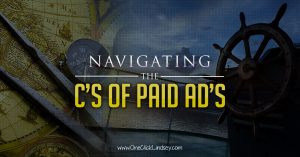If you’re new to online marketing you’ve probably recently discovered that Internet marketing is the land of abbreviations. CPM, CPC, CPL, CPA, CTR, what does it all mean?
Don’t fret, we spell it out for you in this week’s #WhatisWednesday!
Let’s start with CPM.
CPM
CPM stands for cost per thousand. This means you are charged per 1,000 impressions. (Impressions are the number of times your ad has been seen.) This form of payment allows you to reach the most people, but does not track the number of people who actually click on your ad.
Pro: CPM is a great way to increase brand recognition. It gets your ad in front of the most people. This is a great way for a new business to get their name and face out into the market.
Con: CPM is not the most cost effective way to market. The cost of an ad can jump in a short amount of time, depending on how many people view your ad. Your cost per click will inevitably be higher than with other methods, because you are paying per view, regardless of if your ad is clicked on.
CPC
CPC stands for Cost per Click. When using this method, you are only charged each time someone clicks the link on your ad. Your ad will most likely reach less people than with CPM, but you will be able to track how many people made it from the ad to your site. CPC is also sometimes referred to as PPC (Pay per Click)
Pros: You don’t pay per view, so people will be able to view your ad at no cost to you! CPC also provides a clear way to measure the number of people your ad is attracting to your site.
Cons: In order for your ad to be seen and potentially clicked, you have to outbid other advertisers.
CPL
CPL is the abbreviation for cost per lead. When you use this method, you only pay each time someone views your ad, clicks on it, then takes action to become a qualified lead, such as subscribing to a newsletter or free offer.
Pros: Great way to add clients to your listserv and newsletter and start them on a funnel towards a sale.
Cons: One of the most expensive methods and may not result in any sales, if you do not follow up.
CPA
Cost Per Acquisition is similar to cost per lead, but in addition to viewing your ad and clicking on it, the person must complete a purchase before you are charged. This is the most expensive of all the options, but is a good choice if you want to know how much you’re spending on marketing vs. how much you are making in sales.
Pros: With CPA, you are paying for action. You are guaranteed to make money or acquire new customers.
Cons: This is the most expensive method and, like with CPL, you must outbid others vying for their ad to be seen as well.
CTR
Click Through Rate is the number of times your ad was clicked divided by the number of times it was seen (impressions). CTR are important because the higher your ratio, the less expensive a CPC campaign will be.
When you break it down, the C’s really aren’t so complicated, are they?


